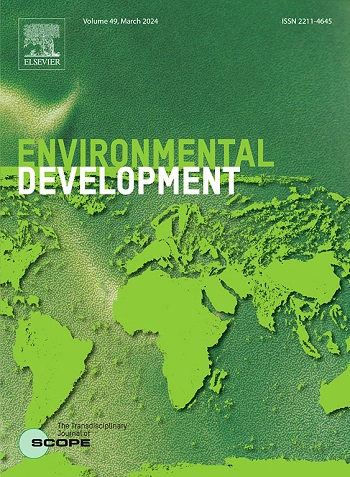量化印度德里半干旱城市森林生态系统碳储量、树木多样性和碳信用潜力
IF 5.3
2区 环境科学与生态学
Q2 ENVIRONMENTAL SCIENCES
引用次数: 0
摘要
城市森林在增强生物多样性、减缓气候变化、改善城市整体环境等方面具有重要作用。尽管人们越来越认识到树木在减缓气候变化中的作用,但有限的研究对德里等半干旱城市生态系统中的树木多样性、生态系统碳库和碳信用潜力进行了全面量化。本研究的重点是量化德里贾瓦哈拉尔·尼赫鲁大学城市半干旱森林的树木多样性、碳储量和碳信用潜力。研究评估了树木生物量、凋落物、林下植被和土壤有机碳(SOC)(包括微生物生物量碳)的碳储量,以评估它们对碳储量的贡献及其通过碳信用的经济潜力。利用树种特异异速生长方程和木材密度值估算树木生物量和碳储量。每个样地在0 ~ 30 cm深度采集土壤样品,采用Walkley-Black法分析有机碳。封存碳的货币价值是通过将总碳储量乘以自愿碳市场的现行价格(每吨二氧化碳当量美元)来计算的。鉴定出优势树种11种,密度为826株ha - 1,基面积为18.01 m2 ha - 1。印楝和尼罗刺槐的CO2固存潜力最高,分别为55.10 Mg CO2 ha-1和54.43 Mg CO2 ha-1,相应的经济价值为771.40美元和762.02美元ha-1。相比之下,决明子瘘的CO2固存潜力最低,为0.23 Mg CO2 ha-1,价值为3.22 ha-1美元。碳库是最大的贡献者,占总碳储量的43.21%,为149.73 Mg CO2 ha-1,价值2096.20 ha-1美元。林下植被、MBC和凋落物对城市碳动态的贡献也很大,表明地上和地下组分在城市碳动态中的重要性。研究结果强调了城市森林在固碳和碳信用产生方面的潜力,并倡导有必要进行战略性城市规划,整合绿色基础设施,以支持德里等城市的可持续发展。本文章由计算机程序翻译,如有差异,请以英文原文为准。
Quantifying ecosystem carbon storage, tree diversity, and carbon credit potential in the urban semi-arid forests of Delhi, India
Urban forest plays crucial role in enhancing biodiversity, mitigating climate change, and improving overall urban environments. Despite growing recognition of their role in climate mitigation, limited studies have comprehensively quantified tree diversity, ecosystem carbon pools, and carbon credit potential in semi-arid urban ecosystems like Delhi. This study focusses on quantifying tree diversity, carbon storage, and carbon credit potential in the urban semi-arid forest of Jawaharlal Nehru University, Delhi. The research assessed carbon storage in tree biomass, litter, understory, and soil organic carbon (SOC) including microbial biomass carbon (MBC), to evaluate their contributions to carbon stocks and their economic potential through carbon credits. Tree biomass and carbon stock were estimated using species-specific allometric equations and wood density values. Soil samples were collected from each plot at a depth of 0–30 cm and analyzed for organic carbon using the Walkley-Black method. The monetary value of sequestered carbon was calculated by multiplying the total carbon stock by the prevailing rate in the voluntary carbon market (USD per ton of CO2 equivalent). The study identified 11 dominant tree species with a density of 826 individual's ha−1 and a basal area of 18.01 m2 ha−1. Azadirachta indica and Acacia nilotica exhibited the highest CO2 sequestration potentials at 55.10 Mg CO2 ha−1 and 54.43 Mg CO2 ha−1, correspondingly to economic values of $771.40 and $762.02 ha-1. In contrast, Cassia fistula showed the lowest CO2 sequestration potential at 0.23 Mg CO2 ha−1, with a value of $3.22 ha-1. The SOC pool was the largest contributor, accounting for 43.21 % of total carbon storage, with 149.73 Mg CO2 ha−1, valued at $ 2096.20 ha-1. Understory vegetation, MBC, and litter also contributed significantly, underscoring the importance of both above- and below-ground components in urban carbon dynamics. The findings underscore the potential of urban forest for carbon sequestration and carbon credit generation, advocating the need for strategic urban planning that integrates green infrastructure to support sustainable development in cities like Delhi.
求助全文
通过发布文献求助,成功后即可免费获取论文全文。
去求助
来源期刊

Environmental Development
Social Sciences-Geography, Planning and Development
CiteScore
8.40
自引率
1.90%
发文量
62
审稿时长
74 days
期刊介绍:
Environmental Development provides a future oriented, pro-active, authoritative source of information and learning for researchers, postgraduate students, policymakers, and managers, and bridges the gap between fundamental research and the application in management and policy practices. It stimulates the exchange and coupling of traditional scientific knowledge on the environment, with the experiential knowledge among decision makers and other stakeholders and also connects natural sciences and social and behavioral sciences. Environmental Development includes and promotes scientific work from the non-western world, and also strengthens the collaboration between the developed and developing world. Further it links environmental research to broader issues of economic and social-cultural developments, and is intended to shorten the delays between research and publication, while ensuring thorough peer review. Environmental Development also creates a forum for transnational communication, discussion and global action.
Environmental Development is open to a broad range of disciplines and authors. The journal welcomes, in particular, contributions from a younger generation of researchers, and papers expanding the frontiers of environmental sciences, pointing at new directions and innovative answers.
All submissions to Environmental Development are reviewed using the general criteria of quality, originality, precision, importance of topic and insights, clarity of exposition, which are in keeping with the journal''s aims and scope.
 求助内容:
求助内容: 应助结果提醒方式:
应助结果提醒方式:


